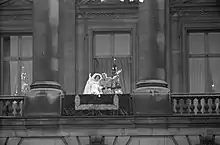Wedding of Baudouin of Belgium and Fabiola de Mora y Aragón
The wedding of King Baudouin of Belgium and Doña Fabiola de Mora y Aragón took place on Thursday, 15 December 1960 in the Throne Room of the Royal Palace of Brussels and at the Cathedral of St. Michael and St. Gudula. King Baudouin was the eldest son of King Leopold III of Belgium and Princess Astrid of Sweden, while Doña Fabiola was the sixth child of Don Gonzalo de Mora y Fernández, 4th Marqués de Casa Riera, and Doña Blanca de Aragón y Carrillo.
 | |
| Date | 15 December 1960 |
|---|---|
| Venue | Royal Palace of Brussels Cathedral of St. Michael and St. Gudula |
| Location | Brussels, Belgium |
| Participants | King Baudouin of Belgium Doña Fabiola de Mora y Aragón |
Engagement
The marriage of King Baudouin, who acceded to the throne in 1950, was of great interest to the Belgian people. Leo Joseph Suenens, Auxiliary Bishop of Mechelen, took matters into his own hands and sent Irish nun, Sister Veronica O’Brien, to find him a devout Catholic, Spanish, aristocratic wife. Sister O'Brien believed she found the perfect candidate in Fabiola, who was then working as a hospital nurse.[1]
The couple announced their engagement on 16 September 1960 at the Castle of Laeken. The news came as a pleasant surprise to the Belgian people, who were not aware the King was seeing anyone.[2][3]
The wedding attracted media attention, both in Belgium and Spain and abroad. In its 6 September 1960, issue, TIME magazine called Doña Fabiola the "Cinderella Girl" and described her as "an attractive young woman, though no raving beauty" and "the girl who could not catch a man."[4] Spanish bakers set out to honour the impending marriage by creating a type of bread called "la fabiola", which is still made in Palencia.
Pre-wedding celebrations
Prior to departing Spain, Doña María del Carmen Polo y Martínez-Valdés, wife of Generalissimo Francisco Franco, presented Doña Fabiola with a strawberry leaf tiara, resembling a Ducal coronet, with interchangeable rubies, aquamarines and emeralds, on behalf of the Spanish government.
On 13 December, a ball was given at the Cinquantenaire Museum.
On 14 December, a ball was given at the Royal Palace of Brussels.
The wedding

Civil marriage
Prior to the religious service, the couple were married civilly in the Throne Room of the Royal Palace of Brussels. The service was presided over by Albert Lilar, Minister of Justice, Lucien Cooremans, Mayor of Brussels, and a member of the Municipal Council.[5] The witnesses were the groom's father, King Leopold III, his brother-in-law, Hereditary Grand Duke Jean of Luxembourg, the bride's brother, The Marqués of Casa Riera, and the pretender to the Spanish throne, the Count of Barcelona.
Religious marriage
The religious service was conducted by Cardinal Jozef-Ernest van Roey at the Cathedral of St. Michael and St. Gudula. Cardinal Giuseppe Siri read a personal message from Pope John XXIII.[6]
As the King and new Queen left the cathedral Handel's Hallelujah chorus from Messiah was played.
Attire
The bride's white silk and tulle gown, trimmed with ermine, had a high neckline, three-quarter length sleeves with a drop waist and a full skirt. It was designed by Cristóbal Balenciaga and had a 22-foot long train. She wore the Art Deco diamond tiara given to her late mother-in-law at the time of her own marriage in 1926.
The groom wore the uniform of a Lieutenant-General of the Armed Forces with the riband and star of the Belgian Order of Leopold and the collar of the Spanish Order of Isabella the Catholic.[7]
Guests

As a descendant of Christian IX of Denmark, Louis Philippe I of France, Miguel I of Portugal and Francis, Duke of Saxe-Coburg-Saalfeld, Baudouin was closely related to most of the royals in Europe, many of whom were present at his marriage.
The groom's family
- Queen Elisabeth of Belgium, the groom's grandmother
- King Leopold III of Belgium and The Princess of Réthy, the groom's father and stepmother
- The Hereditary Grand Duchess and Hereditary Grand Duke of Luxembourg, the groom's sister and brother-in-law
- The Prince and Princess of Liège, the groom's brother and sister-in-law
- Prince Alexandre of Belgium, the groom's half-brother
- King Leopold III of Belgium and The Princess of Réthy, the groom's father and stepmother
The bride's family
- The Dowager Marquesa of Casa Riera, the bride's mother
- The Countess and Count of Sástago, the bride's sister and brother-in-law
- The Marqués and Marquesa of Casa Riera, the bride's brother and sister-in-law
- The Duchess and Duke of Lécera, the bride's sister and brother-in-law
- Don Jaime de Mora y Aragón, the bride's brother
- The Marquesa and Marqués of Aguilar, the bride's sister and brother-in-law
- The Count de la Rosa de Abarca, the bride's brother
Foreign royal guests
_crowned.svg.png.webp)
.svg.png.webp)
_crowned.svg.png.webp)
_crowned.svg.png.webp)
_crowned.svg.png.webp)
















.svg.png.webp)
.svg.png.webp)
.svg.png.webp)
.svg.png.webp)
.svg.png.webp)
.svg.png.webp)
Other notable guests
Aftermath

King Baudouin and Queen Fabiola were married for 33 years. The couple had no children. Fabiola's five pregnancies ended in miscarriage in 1961, 1962, 1963, 1966 and 1968.[8]
King Baudouin died on 31 July 1993 at the Villa Astrida, Motril in Spain. Queen Fabiola never remarried, dying on 5 December 2014 at Stuyvenberg Castle, Laeken.
References
- "Queen Fabiola of the Belgians - obituary". The Telegraph. Retrieved 16 November 2019.
- "KING BAUDOUIN TO MARRY". AP Archive. Retrieved 7 August 2020.
- "Baudouin Engaged 1960". British Pathé. Retrieved 7 August 2020.
- "BELGIUM: Cinderella Girl". 26 September 1960. Retrieved 7 August 2020.
- "Wedding of King Baudouin of Belgium". The Royal Watcher. Retrieved 16 November 2019.
- "Royal Wedding (1960)". YouTube. British Pathé. Retrieved 16 November 2019.
- "Wedding of King Baudouin of Belgium". The Royal Watcher. Retrieved 16 November 2019.
- "Queen Fabiola of the Belgians - obituary". The Telegraph. Retrieved 16 November 2019.